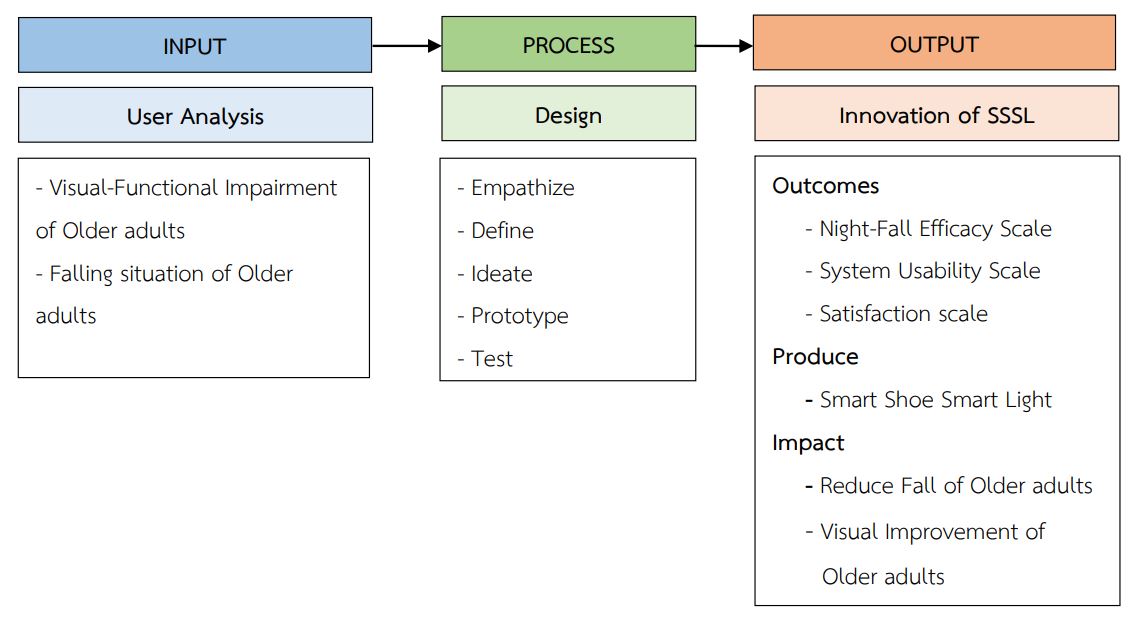Development of an Automatic Night-Illuminating Shoe Innovation Using a Design Thinking Process and Interdisciplinary Integration to Enhance Walking Confidence Perception among Older Adults in the Community
Keywords:
Innovation, Illuminating Shoes, Older Adults, Design Thinking, Interdisciplinary IntegrationAbstract
The objective of this research and development study was to develop and evaluate the effectiveness of an automatic night-illuminating shoe innovation using a design thinking process on the walking confidence perception of older adults in the community. Participants consisted of 30 older adults from the community, selected by purposive sampling. The research tool included the automatic night-illuminating shoes for older adults in the community, developed by the researchers. The data collection tools were as follows: 1) the automatic illuminating shoes, 2) a walking confidence assessment form for night-time activities for older adults, 3) an innovation usability assessment form, and 4) a satisfaction assessment form for older adults. Data were analyzed using descriptive statistics and a One Sample t-test.
The results revealed that after using the automatic night-illuminating shoe innovation, participants had a high mean walking confidence score during nighttime activities (Mean = 4.37, S.D. = 0.33), significantly higher than the standard criterion score (Mean = 3.50) (p-value < 0.001). The mean usability score for the automatic night-illuminating shoe innovation was also high (Mean = 4.34, S.D. = 0.40), significantly exceeding the standard criterion score (Mean = 3.50) (p-value < 0.001). Additionally, the mean satisfaction score of older adults regarding the use of the automatic night-illuminating shoes was high (Mean = 4.42, S.D. = 0.40), significantly above the high standard criterion score (Mean = 3.50) (p-value < 0.001). Therefore, the development of the prototype automatic night-illuminating shoes using a design thinking process successfully enhanced walking confidence among older adults in the community.
References
กมลทิพย์ ตั้งหลักมั่นคง และคณะ. (2564). ประสิทธิผลของการประยุกต์ใช้การคิดเชิงออกแบบและการเรียนรู้แบบ สหสาขาวิชาชีพต่อการพัฒนาทักษะการเรียนรู้ (4Cs) และสมรรถนะในการทำงานร่วมกันแบบสหสาขาวิชาชีพในวิชานวัตกรรมทางการพยาบาล. Journal of Information and Learning, 32(3), 14-24.
จารุณี มุมบ้านเซ่า. (2559). การวิจัยแบบบูรณาการข้ามศาสตร์. วารสารสังคมสงเคราะห์ศาสตร์, 25(1), 119-132.
จิรัชยา เคล้าดี, สุภชัย นาคสุวรรณ์ และจักรวาล สุขไมตรี. (2560). ปัจจัยที่มีผลต่อคุณภาพชีวิตของผู้สูงอายุในจังหวัดนครศรีธรรมราช. วารสารราชพฤกษ์, 15(1), 27-32.
ฉัตรชฎา สุตาลังกา, วิลาวัณย์ ไชยอุต, พลอยไพลิน นามกร และนิรันดร์ เงินแย้ม. (2565). ความสัมพันธ์ระหว่างข้อมูลพื้นฐานสมรรถภาพสมองการทำงานของสมองด้านการจัดการสมรรถภาพทางกาย กับความกลัว การล้มของผู้สูงอายุในชุมชน. วารสารจิตวิทยาคลินิกไทย, 53(2), 16-31.
ชวพร ธรรมนิตยกุล และกันยารัตน์ ศรีวิสทิยกุล. (2565). ความต้องการและรูปแบบการสื่อสารนวัตกรรมเพื่อส่งเสริมทักษะความเป็นพลเมืองดิจิทัลด้านความปลอดภัยทางเทคโนโลยีสารสนเทศสำหรับผู้สูงอายุ. วารสารมนุษยศาสตร์วิชาการ, 31(1), 75-93.
ชูศรี วงศ์รัตนะ. (2553). เทคนิคการใช้สถิติเพื่อการวิจัย. (พิมพ์ครั้งที่ 12). กรุงเทพฯ: ไทเนรมิตกิจ อินเตอร์ โปรเกรสซิฟ.
ธนู อ่อนอุดม. (2558). การรับรู้ในสนุทรียศาสตร์ของผู้บกพร่องการมองเห็น. วิทยานิพนธ์ศิลปศาสตรมหาบัณฑิตสาขาวิชาการออกแบบ บัณฑิตวิทยาลัย มหาวิทยาลัยรังสิต.
นาถนภา กิตติจารุนันท์. (2561). ผลกระทบของระดับความส่องสว่างและอุณหภูมิสีของแสงต่อความเร็วและความถูกต้องในการอ่านหนังสือของผู้สูงอายุ. วิทยานิพนธ์วิทยาศาสตรมหาบัณฑิต สาขาวิชาสถาปัตยกรรม บัณฑิตวิทยาลัย จุฬาลงกรณ์มหาวิทยาลัย.
ประเสริฐ ศรีนวล และธนัช กนกเทศ. (2564). อุบัติเหตุพลัดตกหกล้มในผู้สูงอายุ: ผู้สูงอายุไทยความมั่นใจที่ปัญญาชาวบ้านโดยเทคนิคการสะท้อนแสง Bamboo Louvers Design for the Elder in Local Resident by Daylight Reflecting Technique. วารสารวิชาการการออกแบบสภาพแวดล้อม, 3(1), 89-111.
ปิติภัทร ปิ่นบุตร, กายรัฐ เจริญราษฎร์, กิตติพงษ์ ภู่พัฒน์วิบูลย์ฒ และณัฐชามญฑ์ ศรีเจริญรัตนา. (2563). การประยุกต์ใช้เสียงเพื่อควบคุมแสงสว่างบ้านอัจฉริยะสำหรับผู้สูงอายุ. วารสารวิทยาการจัดการมหาวิทยาลัยราชภัฏนครปฐม, 7(1), 306-319.
พิชามญชุ์ สุรียพรรณ, สุทธิศิลป์ สุขสบาย, ปารณีย์ ชั่งกฤษ และมหิดล สุรียพรรณ. (2565). การพัฒนานวัตกรรมสำหรับผู้สูงอายุด้วยกระบวนการคิดเชิงออกแบบ. วารสารวิชาการสถาบันการอาชีวศึกษาภาคใต้ 1, 7(2), 33-40.
ยลดา ไชยรี. (2563). แสงในงานสถาปัตยกรรมไทย: การประยุกต์ในรีสอร์ทจังหวัดกาญจนบุรี. วิทยานิพนธ์วิทยศาสตรมหาบัณฑิต สาขาวิชาชาสถาปัตยกรรม บัณฑิตวิทยาลัย มหาวิทยาลัยศรีปทุม.
ยุทธนา ทองท้วม. (2559). การพัฒนารูปแบบช่อแสงไม้ไผ่สำหรับผู้สูงอายุในที่พักอาศัยที่ใช้ภูมิปัญญาชาวบ้าน โดยเทคนิคการสะท้อนแสง. วารสารวิชาการการออกแบบสภาพแวดล้อม, 3(1), 89-111.
ยุพาวดี ขันทบัลลัง และคณะ. (2565). การพัฒนาและประสิทธิผลของนวัตกรรมอุปกรณ์เคลื่อนย้ายผู้สูงอายุ. วารสารสุขภาพและการศึกษาพยาบาล, 28(1), e257969.
วันทนา ศุขมณี และอนุวัฒน์ ชั้นกลาง. (2560). ไม้เท้าอัจฉริยะ (Smart Cane). การประชุมวิชาการระดับชาติ ราชมงคลสุรินทร์วิชาการ ครั้งที่ 8 วิจัยเพื่อประเทศไทย 4.0 มหาวิทยาลัยเทคโนโลยีราชมงคลอีสาน วิทยาเขตสุรินทร์.
โสภิดา ท้วมมี, หทัยรัตน์ เกตุมณีชัยรัตน์, ฌัลลิกา เพชรมณีนิลใส และพศวัต พันธ์โสตถี. (2565). ไม้เท้าอัจฉริยะสำหรับช่วยเหลือผู้พิการทางสายตา. วารสารวิชาการเทคโนโลยีอุตสาหกรรม, 18(2), 22-39.
Broman, A. T., West, S. K., Munoz, B., Bandeen-Roche, K., Rubin, G. S., & Turano, K. A. (2004). Divided visual attention as a predictor of bumping while walking: The salisbury eye evaluation. Investigative Ophthalmology & Visual Science, 45(9), 2955-2960. https://doi.org/10.1167/iovs.04-0219
Cohen, J. (1977). Statistical power analysis for the behavioral sciences. New York: Academic Press.
Faul, F., Erdfelder, E., Lang, A.-G., & Buchner, A. (2007). G*Power 3: A flexible statistical power analysis program for the social, behavioral, and biomedical sciences. Behavior Research Methods, 39, 175-191. https://doi.org/10.3758/bf03193146
Ferguson, E. L., et al. (2024). Visual Impairment, Eye Conditions, and Diagnoses of Neurodegeneration and Dementia. JAMA Network Open, 7(7), e2424539. https://doi.org/10.1001/jamanetworkopen.2024.24539
Freeman, E. E., Munoz, B., Rubin, G., & West, S. K. (2007). Visual field loss increases the risk of falls in older adults: The Salisbury eye evaluation. Investigative Ophthalmology & Visual Science, 48(10), 4445-4450. https://doi.org/10.1167/iovs.07-0326
Gall, M. D., Gall, J. P., & Borg, W. R. (2007). Educational research: An Introduction (8th ed.). New York: Pearson Education.
Gravetter, F. J., & Wallnau, L. B. (2016). Statistics for the behavioral sciences (10th ed.). Boston: Cengage Learning.
Jefferis, B. J., et al. (2014). How are falls and fear of falling associated with objectively measured physical activity in a cohort of community-dwelling older men?. BMC Geriatrics, 14(1), 114. https://doi.org/10.1186/1471-2318-14-114
Kakara, R., Bergen, G., Burns, E., & Stevens, M. (2023). Nonfatal and fatal falls among adults aged ≥65 years - United States, 2020-2021. MMWR. Morbidity and Mortality Weekly Report, 72(35), 938-943. https://doi.org/10.15585/mmwr.mm7235a1
Li, Y., Hou, L., Zhao, H., Xie, R., Yi, Y., & Ding, X. (2023). Risk factors for falls among community-dwelling older adults: A systematic review and meta-analysis. Frontiers in Medicine, 9, 1019094. https://doi.org/10.3389/fmed.2022.1019094
MacKay, S., Ebert, P., Harbidge, C., & Hogan, D. B. (2021). Fear of Falling in Older Adults: A scoping review of recent literature. Canadian Geriatrics Journal, 24(4), 379-394. https://doi.org/10.5770/cgj.24.521
Reed-Jones, R. J., Solis, G. R., Lawson, K. A., Loya, A. M., Cude-Islas, D., & Berger, C. S. (2013). Vision and falls: A multidisciplinary review of the contributions of visual impairment to falls among older adults. Maturitas, 75(1), 22-28. https://doi.org/10.1016/j.maturitas.2013.01.019
Saftari, L. N. & Kwon, O. S. (2018). Ageing vision and falls: A review. Journal of Physiological Anthropology, 37(1), 1-14. https://doi.org/10.1186/s40101-018-0170-1
Thanomwong, A., Khomarwut, S., Satrakom, W., & Wonngnuch, P. (2020). Prevalence and Factor Associated with falling among older adults in Ban Den San Sai Village, Thung Ko Sub-district, Wiang Chiang Rung District, Chiang Rai Province, Thailand. Journal of Health Science Alternative Medicine, 2(2), 23-26.
Vo, M. T. H., Thonglor, R., Moncatar, T. J. R., Han, T. D. T., Tejativaddhana, P., & Nakamura, K. (2023). Fear of falling and associated factors among older adults in Southeast Asia: A systematic review. Public Health, 222, 215-228. https://doi.org/10.1016/j.puhe.2022.08.012

Downloads
Published
How to Cite
Issue
Section
License
Copyright (c) 2024 Journal of Nursing and Public Health Research

This work is licensed under a Creative Commons Attribution-NonCommercial-NoDerivatives 4.0 International License.
1. บทความหรือข้อคิดเห็นใด ๆ ที่ปรากฏในวารสารวิจัยการพยาบาลและการสาธารณสุข ที่เป็นวรรณกรรมของผู้เขียน บรรณาธิการไม่จำเป็นต้องเห็นด้วย
2. บทความที่ได้รับการตีพิมพ์ถือเป็นลิขสิทธิ์ของ วารสารวิจัยการพยาบาลและการสาธารณสุข








